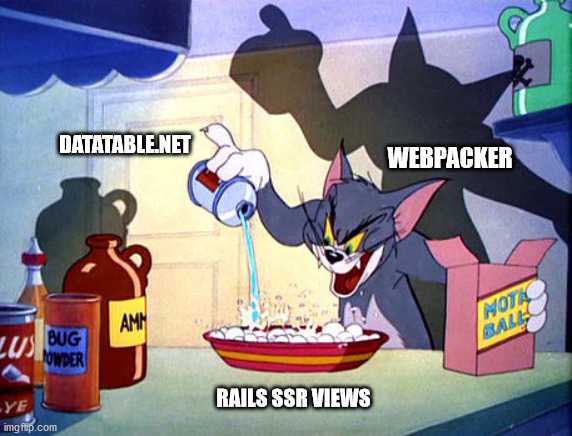Integrating DataTables.net into Rails with Webpacker
Hey there,
This article is about an opinionated way to integrate DataTables.net into a Rails 6 project with Webpacker for server-rendered views. I hope this article and code bits can help people with similar use cases in setting thing up.
Premise
Back then on Ruby on Rails, we could just place every js files in the /assets directory and Sprockets will compile everything in it. Then, all methods and symbols will be readily available on the global scope to be used on Rails server-rendered views.
When I started a new Rails project at work, I discovered that we can use Webpacker to compile our js files and leverage the abundance of packages from npm . Also, I quickly found out that Webpacker does not expose all methods and classes included in all js files globally, while trying to debug it for hours. 😂
From my crude understanding of how Webpacker works, as js files are compiled into individual modules, so do the methods and classes defined are packaged into its very own scope. It means that things do not get leaked into other modules unless being required or imported. The same applies to global scope.
I found ways to import jQuery at the global scope via a global import but the same approach does not work to expose DataTables.net at the global scope of $.
How I want this to work
jQueryandDataTables.netcompiled and initialised atapplication.jslevel for ease of maintainance.jQueryand initialisedDataTables.netinstance must exists at global scope for server-rendered views.
Steps
Installing Dependencies
-
Get the necessities
yarn add jquery datatables.net datatables.net-dtPlease refer to https://datatables.net/download/npm to know which relevant
DataTables.netrelease to get for your preferred stying framework. -
Get
webpackloadersyarn add -D css-loader expose-loader imports-loader -
Add the following
jsfiles that defined the packages we want to load.-
jQueryloader, save atconfig/webpack/loaders/jquery.js// expose-loader helps us to expose the jquery module as $ and jQuery at // the global object, allowing us to access it at Rails server-rendered // views. module.exports = { test: require.resolve("jquery"), loader: "expose-loader", options: { exposes: ["$", "jQuery"], }, }; -
DataTables.netloader, save atconfig/webpacker/loaders/datatables.js// datatables.net relies on the jquery global variable to work. // import-loader helps us to add the necessary require('jquery') so the // jquery variable is available when any datatables.net packages are loaded. // refer to https://webpack.js.org/loaders/imports-loader/ module.exports = { test: /datatables\.net.*/, loader: "imports-loader", options: { // Disables AMD plugin as DataTables.net // checks for AMD before CommonJS. additionalCode: "var define = false;", }, };
-
-
At
config/webpacker/environment.js, we will append our loaders towebpackand add aProviderPlugin.const { environment } = require("@rails/webpacker"); const webpack = require("webpack"); // import our loaders. const datatables = require("./loaders/datatables"); const jquery = require("./loaders/jquery"); // append them to webpack loaders. environment.loaders.append("datatables", datatables); environment.loaders.append("expose", jquery); // ProviderPlugin helps us to load jQuery when the variables of $ and jQuery // are encountered as free variables at other modules. // Let's say if you want to use Bootstrap 4 and Popper.js. // // Refer here https://webpack.js.org/plugins/provide-plugin/ environment.plugins.append( "Provide", new webpack.ProvidePlugin({ $: "jquery", jQuery: "jquery", }) ); module.exports = environment; -
At
app/javascript/packs/application.jsimport dt from "datatables.net"; document.addEventListener("turbolinks:load", () => { dt(window, $); }); -
At whatever views you have. Let's say
app/views/members/index.html.slim.h1 Member List table#member-table thead tr td Member ID td Family Name td Given Name td Birth Day tbody - @members.each do |member| tr td = member.id td = member.famil_name td = member.given_name td = member.birthdate.strftime('%d %B %Y') / Just slap this in. javascript: document.addEventListener('turbolinks:load', function() { $('#member-table').DataTable(); }); - Import 'datatables.net-dt/css/jquery.datatables.css' with your preferred method.
That should do the trick. Now:
- Our
DataTables.nethave the neededjqueryvariable within its scope. DataTables.netis initialised atapplication.jslevel.- We get to access
$(<query>).DataTable()at the global scope at any Rails server-rendered views.
Example project
I have setup an example projects with the workings here.
References and citations
The approach in this article is a compilation of solutions from many precursors asking and answering the same question.
I might have missed out some references here.
- https://stackoverflow.com/questions/29080148/expose-jquery-to-real-window-object-with-webpack
- https://github.com/jbox-web/ajax-datatables-rails/blob/master/doc/webpack.md
- https://webpack.js.org/plugins/provide-plugin/#usage-jquery
- https://webpack.js.org/loaders/expose-loader/#root
- https://webpack.js.org/loaders/imports-loader/
- https://stackoverflow.com/questions/57964095/rails-6-webpack-datatables-jquery
- https://datatables.net/forums/discussion/57642/installation-issues-rails-yarn-webpacker

